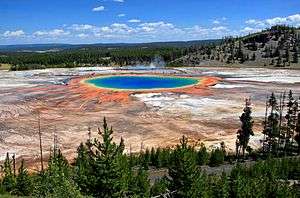Grand Prismatic Spring
| Grand Prismatic Spring | |
|---|---|
 An aerial view of Grand Prismatic Spring | |
| Location | Midway Geyser Basin, Yellowstone National Park, Teton County, Wyoming |
| Coordinates | 44°31′30″N 110°50′17″W / 44.5250489°N 110.83819°WCoordinates: 44°31′30″N 110°50′17″W / 44.5250489°N 110.83819°W[1] |
| Elevation | 7,270 feet (2,220 m)[2] |
| Type | Hot spring |
| Discharge | 560 US gallons (2,100 L) per minute |
| Temperature | 160 °F (70 °C) |
| Depth | 160 feet (50 m) |
The Grand Prismatic Spring in Yellowstone National Park is the largest hot spring in the United States, and the third largest in the world,[3] after Frying Pan Lake in New Zealand and Boiling Lake in Dominica. It is located in the Midway Geyser Basin.
Grand Prismatic Spring was noted by geologists working in the Hayden Geological Survey of 1871, and named by them for its striking coloration. Its colors match the rainbow dispersion of white light by an optical prism: red, orange, yellow, green, and blue.[4]
History
The first records of the spring are from early European explorers and surveyors. In 1839, a group of fur trappers from the American Fur Company crossed the Midway Geyser Basin and made note of a "boiling lake", most likely the Grand Prismatic Spring,[5] with a diameter of 300 feet (90 m). In 1870 the Washburn–Langford–Doane Expedition visited the spring, noting a 50-foot (15 m) geyser nearby (later named Excelsior).[6][7]
Color
The vivid colors in the spring are the result of microbial mats around the edges of the mineral-rich water. The mats produce colors ranging from green to red; the amount of color in the microbial mats depends on the ratio of chlorophyll to carotenoids and on the temperature gradient in the runoff. In the summer, the mats tend to be orange and red, whereas in the winter the mats are usually dark green.[8] The center of the pool is sterile due to extreme heat.
The deep blue color of the water in the center of the pool results from the scattering of blue light by particles suspended in the water.[9] This effect is particularly visible in the center of the spring due to the lack of archaea that live in the center and the depth of the water.[10]
Physical structure
The spring is approximately 370 feet (110 m) in diameter and is 160 feet (50 m) deep. The spring discharges an estimated 560 US gallons (2,100 L) of 160 °F (70 °C) water per minute.[10][11]
Gallery
References
- ↑ "Grand Prismatic Spring". Yellowstone Geothermal Features Database. Montana State University.
- ↑ "Grand Prismatic Spring". Geographic Names Information System. United States Geological Survey.
- ↑ "Steam Explosions, Earthquakes, and Volcanic Eruptions—What's in Yellowstone's Future?". U.S. Geological Survey.
- ↑ Traci Bryan; Leslie Machen; Joyce Heinsz; Peggy McCracken. "Grand Prismatic Spring". Lunar and Planetary Institute. Retrieved December 4, 2015.
- ↑ ""The Fire Hole": Era of the American Fur Company, 1833-1840". Colter's Hell & Jackson's Hole. National Park Service.
- ↑ "Notes". Yellowstone National Park: Its Exploration and Establishment. National Park Service.
- ↑ "Part II: Definitive Knowledge - The Washburn Party (1870)". Yellowstone National Park: Its Exploration and Establishment. National Park Service.
- ↑ Thomas D. Brock. "Colorful Yellowstone". Life at High Temperatures. Archived from the original on 2005-11-25.
- ↑ Grand Prismatic Spring informational sign (unattributed), photographed 17 August 2011.
- 1 2 Geiling, Natasha. "The Science Behind Yellowstone's Rainbow Hot Spring". Smithsonian.com. Smithsonian Institution. Retrieved 17 August 2015.
- ↑ "Grand Prismatic Spring". Geyser Observation and Study Association.
External links
 Media related to Grand Prismatic Spring at Wikimedia Commons
Media related to Grand Prismatic Spring at Wikimedia Commons




